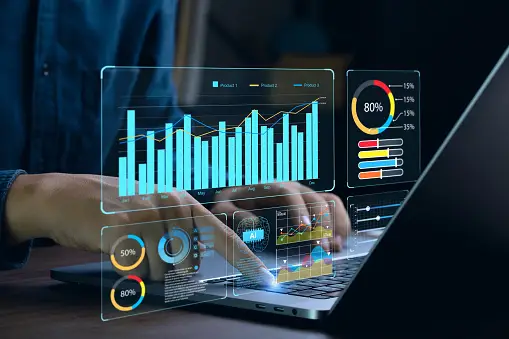In today’s cutthroat digital landscape, mastering Search Engine Marketing (SEM) is crucial for businesses striving to stay ahead in competitive industries. SEM encompasses a variety of techniques to increase a website’s visibility in search engine results pages (SERPs) through paid advertising. While SEM can be a powerful tool for driving targeted traffic and generating leads, it requires strategic finesse, especially in fiercely competitive sectors. Let’s delve into some advanced SEM strategies tailored for such industries.

Understanding the Landscape
Competitive industries, such as finance, healthcare, and technology, often face steep competition for keywords and ad placements. Understanding your niche’s landscape is paramount. Conduct thorough competitor analysis to identify key players, their strategies, and areas of opportunity. Leverage tools like SEMrush, Ahrefs, or SpyFu to gain insights into competitors’ ad campaigns, keywords, and ad creatives.
Niche Targeting and Long-Tail Keywords
In competitive industries, broad keywords can be prohibitively expensive and less effective due to high competition. Instead, focus on niche targeting and long-tail keywords. Long-tail keywords are more specific phrases that typically have lower search volume but higher conversion rates. Tailor your campaigns to target these keywords, as they attract users with clearer intent and are often less competitive, offering better ROI.
Ad Extensions and Enhanced Sitelinks
Enhance your ads with extensions to provide additional information and improve visibility. Ad extensions like site links, callouts, structured snippets, and location extensions offer more real estate on SERPs, making your ads more prominent and informative. Utilize these extensions strategically to highlight unique selling points, promotions, or specific services, enticing users to click on your ad over competitors’.
Ad Customizers and Dynamic Keyword Insertion
Dynamic ad customizers allow you to personalize ad content based on users’ search queries, increasing relevance and click-through rates (CTR). Implement dynamic keyword insertion to dynamically update ad copy with the keyword that triggered the ad, making it more compelling and contextually relevant. This level of customization can give your ads an edge in competitive auctions by aligning closely with users’ search intent.
Remarketing and Audience Targeting
In competitive industries, converting leads into customers can be challenging. Employ remarketing strategies to re-engage users who have previously interacted with your website but haven’t converted. Segment your audience based on their behavior and demographics, then tailor ad messaging and offers accordingly. Dynamic remarketing, which displays personalized ads featuring previously viewed products or services, can be particularly effective in driving conversions.
A/B Testing and Continuous Optimization
Continuous optimization is essential for success in competitive SEM. Conduct A/B tests regularly to refine ad copy, landing pages, and targeting parameters. Test different ad variations, bidding strategies, and targeting options to identify what resonates best with your audience. Leverage data-driven insights to make informed decisions and iterate on your campaigns, staying agile and adaptive in the face of evolving competition.
Leveraging AI and Automation
Harness the power of artificial intelligence (AI) and automation to streamline campaign management and maximize efficiency. AI-driven platforms can analyze vast amounts of data to optimize bidding, targeting, and ad creative in real-time, helping you stay ahead of the competition. Explore automation features offered by advertising platforms like Google Ads and Microsoft Advertising to automate routine tasks and free up time for strategic planning and innovation.
Conclusion
In competitive industries, mastering SEM requires a combination of strategic thinking, creative execution, and relentless optimization. By understanding the landscape, targeting niche audiences, leveraging advanced ad formats and customization options, and embracing AI-driven automation, businesses can gain a competitive edge in the digital arena. Continuously monitor performance metrics, adapt to changing trends, and refine your strategies to stay ahead of the curve and achieve sustained success in competitive industries.
Harnessing Competitive Intelligence
In competitive industries, staying ahead often means staying informed. Utilize competitive intelligence tools to gain deeper insights into your rivals’ strategies. Analyze their ad copy, landing pages, and keyword targeting to identify gaps and opportunities. Keep a close eye on competitor activity and adapt your own campaigns accordingly. By understanding what works for your competitors and what doesn’t, you can fine-tune your SEM strategies for maximum impact.
Quality Score Optimization
Quality Score is a crucial metric in SEM that directly impacts ad rank and cost-per-click (CPC). In competitive industries, where bidding wars are common, optimizing your Quality Score can give you a significant advantage. Focus on improving factors like ad relevance, landing page experience, and expected click-through rate (CTR). Tailor your ad messaging to closely match users’ search intent and ensure that landing pages provide valuable, relevant content and a seamless user experience.
Strategic Bid Management
Effective bid management is paramount in competitive SEM campaigns. Instead of relying solely on manual bidding, consider leveraging automated bidding strategies like target CPA (Cost Per Acquisition) or target ROAS (Return On Ad Spend). These automated strategies use machine learning algorithms to adjust bids in real-time based on conversion data, maximizing your ROI while minimizing manual effort. Experiment with different bidding strategies and adjust bid adjustments based on performance to maintain a competitive edge.
Localized Targeting and Geotargeting
For businesses operating in competitive industries with a local presence, localized targeting can be a game-changer. Utilize geotargeting to focus your ads on specific geographic locations where your target audience is most concentrated. Tailor ad copy and offers to appeal to local preferences and needs, increasing relevance and driving higher engagement. Additionally, leverage location-based bidding adjustments to allocate budget more efficiently in high-value regions, optimizing your SEM campaigns for local competitiveness.

Cross-Channel Integration
In today’s omnichannel landscape, integrating SEM with other digital marketing channels can amplify your reach and effectiveness. Coordinate your SEM efforts with SEO, social media marketing, email marketing, and other channels to create cohesive, cross-channel campaigns. Align messaging and branding across channels to reinforce brand awareness and engagement. By leveraging multiple touchpoints in the customer journey, you can maximize exposure and conversions, gaining a competitive advantage over competitors who rely solely on SEM.
Continuous Learning and Adaptation
Finally, in competitive industries where the digital landscape is constantly evolving, a mindset of continuous learning and adaptation is essential. Stay updated on industry trends, algorithm changes, and new technologies impacting SEM. Attend industry conferences, webinars, and workshops to network with peers and gain insights from industry experts. Experiment with emerging strategies and tools, and be willing to adapt your approach based on evolving best practices and market dynamics.
In conclusion, mastering SEM in competitive industries requires a holistic approach that combines strategic planning, data-driven optimization, and a commitment to innovation. By leveraging competitive intelligence, optimizing Quality Score, strategic bid management, localized targeting, cross-channel integration, and a mindset of continuous learning, businesses can elevate their SEM strategies to outmaneuver competitors and achieve sustainable growth in even the most fiercely contested markets.
Creative Ad Formats and Multimedia Content
In competitive industries, capturing users’ attention amidst the noise requires creativity and innovation. Explore alternative ad formats beyond traditional text ads, such as responsive display ads, interactive ads, or video ads. These formats offer more engaging and visually appealing experiences, helping your ads stand out in crowded SERPs. Experiment with multimedia content like videos, infographics, or interactive quizzes to convey your message in a compelling and memorable way. By leveraging creative ad formats and multimedia content, you can differentiate your brand and increase engagement, giving you an edge over competitors relying solely on text-based ads.
In-depth Keyword Research and Semantic SEO
In competitive industries, every keyword matters. Conduct comprehensive keyword research to identify high-value keywords with moderate competition and strong commercial intent. Look beyond exact match keywords and explore semantic variations and long-tail keyword clusters related to your niche. Leverage tools like Google Keyword Planner, SEMrush, or Moz Keyword Explorer to uncover keyword opportunities and estimate search volume and competition levels. By targeting a diverse mix of relevant keywords and optimizing your content for semantic SEO, you can broaden your reach and capture more qualified traffic, outmaneuvering competitors fixated on a narrow set of high-volume keywords.
Conversion Rate Optimization (CRO) and User Experience (UX) Enhancement
In competitive industries, driving traffic to your website is only half the battle; converting that traffic into leads or customers is equally important. Invest in conversion rate optimization (CRO) to improve the effectiveness of your landing pages and conversion funnels. Conduct A/B tests to optimize elements like headlines, calls-to-action (CTAs), form fields, and page layouts for maximum conversions. Prioritize user experience (UX) enhancements to ensure that your website is fast, mobile-friendly, and intuitive to navigate. By providing a seamless and frictionless user experience, you can increase conversion rates and gain a competitive advantage in your industry.
Social Proof and Trust Signals
In competitive industries where trust and credibility are paramount, leveraging social proof and trust signals can help differentiate your brand and instill confidence in potential customers. Incorporate customer testimonials, reviews, case studies, and trust badges prominently on your website and landing pages to showcase positive experiences and build credibility. Highlight endorsements from industry influencers or certifications from reputable organizations to further reinforce trustworthiness. By demonstrating social proof and trustworthiness, you can alleviate concerns and objections, increasing conversion rates and outpacing competitors lacking in credibility.

Agile Campaign Management and Real-Time Optimization
In fast-paced and competitive industries, agility is key to staying ahead of the curve. Adopt an agile approach to campaign management, continuously monitoring performance metrics and adjusting strategies in real-time. Leverage real-time data and analytics dashboards to identify trends, opportunities, and potential threats quickly. Be prepared to pivot your strategies and allocate resources dynamically based on changing market conditions and competitor actions. By remaining agile and adaptive, you can capitalize on emerging opportunities and mitigate risks, maintaining a competitive edge in your industry.
In summary, mastering SEM in competitive industries requires a multifaceted approach that encompasses creativity, data-driven insights, user-centricity, and agility. By leveraging creative ad formats, conducting in-depth keyword research, optimizing conversion funnels, showcasing social proof, and adopting an agile campaign management approach, businesses can outmaneuver competitors and achieve sustainable growth in fiercely contested markets.
Hyper-Targeted Audience Segmentation
In competitive industries, the ability to precisely target and personalize marketing messages is a game-changer. Utilize advanced audience segmentation techniques to divide your target audience into hyper-specific segments based on demographics, behaviors, interests, and intent signals. Leverage first-party data from your CRM system, website analytics, and customer interactions to create custom audience segments tailored to different stages of the customer journey. Implement dynamic ad targeting and personalized messaging to deliver relevant content to each segment, increasing engagement and conversions. By hyper-targeting your audience segments, you can maximize the effectiveness of your SEM campaigns and outperform competitors relying on broad, one-size-fits-all approaches.
Voice Search Optimization
With the rising popularity of voice-activated assistants like Siri, Alexa, and Google Assistant, optimizing for voice search is becoming increasingly important in competitive industries. Adapt your SEM strategies to accommodate voice search queries by focusing on conversational language and natural language processing (NLP). Conduct keyword research to identify long-tail keywords and phrases commonly used in voice searches and incorporate them into your ad copy and landing pages. Optimize your website for featured snippets and answer boxes to increase the likelihood of appearing in voice search results. By embracing voice search optimization, you can gain a competitive advantage in the era of voice-enabled devices and conversational search interfaces.
Agile Competitor Analysis and Response
In fast-paced and competitive industries, keeping tabs on competitors’ movements and responding swiftly is crucial. Implement agile competitor analysis techniques to monitor competitors’ SEM campaigns, ad messaging, and landing page strategies in real-time. Utilize competitive intelligence tools and alerts to track changes in competitors’ keyword bids, ad placements, and messaging tactics. Analyze competitors’ strengths and weaknesses to identify gaps and opportunities in the market. Be prepared to adjust your SEM strategies and counter competitors’ moves promptly to maintain a competitive edge. By adopting an agile approach to competitor analysis and response, you can stay ahead of the curve and capitalize on shifting market dynamics.
Localization and Cultural Sensitivity
In global or culturally diverse markets, localization and cultural sensitivity are key factors in SEM success. Tailor your ad campaigns and messaging to resonate with local customs, languages, and cultural nuances. Conduct market research to understand cultural preferences, taboos, and sensitivities in your target regions and adapt your messaging accordingly. Hire native speakers or cultural consultants to ensure accuracy and authenticity in your localized content. Leverage geo-targeting and language targeting features to deliver personalized ads to audiences in different regions. By prioritizing localization and cultural sensitivity in your SEM strategies, you can build trust and rapport with diverse audiences and gain a competitive advantage in global markets.
Continuous Experimentation and Innovation
Innovation is the lifeblood of success in competitive industries. Foster a culture of continuous experimentation and innovation within your SEM team, encouraging them to test new ideas, technologies, and strategies regularly. Implement agile project management methodologies like scrum or Kanban to facilitate rapid iteration and adaptation. Embrace emerging trends and technologies such as artificial intelligence, machine learning, and voice search to stay ahead of the curve. Encourage cross-functional collaboration and knowledge sharing to foster creativity and innovation. By embracing a mindset of continuous experimentation and innovation, you can stay ahead of competitors and drive sustained growth in competitive industries.
In summary, mastering SEM in competitive industries requires a multifaceted approach that encompasses hyper-targeted audience segmentation, voice search optimization, agile competitor analysis, localization, cultural sensitivity, and continuous experimentation and innovation. By leveraging these advanced SEM strategies, businesses can outmaneuver competitors and achieve sustainable growth in fiercely contested markets.

Strategic Partnerships and Joint Ventures
In competitive industries, forming strategic partnerships and joint ventures can provide mutually beneficial opportunities for growth and expansion. Collaborate with complementary businesses or industry leaders to co-create innovative marketing campaigns, share resources, and leverage each other’s strengths. Explore joint ventures to penetrate new markets, introduce new products or services, or access new distribution channels. By forging strategic alliances and partnerships, you can amplify your SEM efforts, reach new audiences, and gain a competitive advantage over rivals operating in isolation.
Predictive Analytics and Machine Learning
In today’s data-driven world, predictive analytics and machine learning are revolutionizing the way businesses approach marketing and advertising. Harness the power of predictive analytics to forecast trends, anticipate customer behavior, and optimize your SEM strategies proactively. Leverage machine learning algorithms to automate bid management, ad targeting, and personalization at scale, freeing up valuable time and resources for strategic planning and innovation. By embracing predictive analytics and machine learning, you can stay ahead of the competition, anticipate market shifts, and capitalize on emerging opportunities more effectively.
Content Syndication and Amplification
Content syndication and amplification are powerful tactics for extending the reach and impact of your SEM campaigns. Syndicate your high-quality content across relevant platforms, publications, and industry forums to increase visibility and attract a wider audience. Leverage content amplification strategies such as native advertising, sponsored content, or influencer partnerships to promote your content to targeted audiences at scale. Incorporate SEM tactics like retargeting and paid social advertising to amplify the reach and engagement of your content across multiple channels. By adopting a comprehensive content syndication and amplification strategy, you can maximize the effectiveness of your SEM efforts and outshine competitors with broader reach and exposure.
Embrace Emerging Platforms and Technologies
Innovative platforms and technologies are constantly reshaping the digital advertising landscape. Stay ahead of the curve by embracing emerging platforms such as TikTok, Snapchat, or Clubhouse, where your target audience may be actively engaged. Experiment with new ad formats, such as augmented reality (AR) ads or shoppable posts, to create immersive and interactive experiences that capture attention and drive engagement. Explore emerging technologies like blockchain-based advertising or virtual reality (VR) experiences to differentiate your brand and stand out in competitive markets. By embracing emerging platforms and technologies, you can stay ahead of competitors and position your brand as a forward-thinking industry leader.
Customer-Centricity and Relationship Building
In competitive industries, building strong relationships with customers is essential for long-term success. Prioritize customer-centricity in your SEM strategies by delivering personalized experiences, addressing customer needs and pain points, and fostering meaningful connections at every touchpoint. Implement CRM systems and marketing automation tools to track customer interactions, preferences, and purchase history, enabling you to tailor your SEM campaigns accordingly. Leverage email marketing, social media engagement, and loyalty programs to nurture relationships with existing customers and encourage repeat business. By prioritizing customer-centricity and relationship building, you can create a loyal customer base that acts as a competitive advantage, driving sustainable growth and differentiation in your industry.

In conclusion, mastering SEM in competitive industries requires a holistic approach that encompasses strategic partnerships, predictive analytics, content syndication, emerging platforms and technologies, customer-centricity, and relationship building. By leveraging these advanced SEM strategies, businesses can outmaneuver competitors, drive sustained growth, and achieve long-term success in fiercely contested markets.
4 thoughts on “Advanced SEM Strategies for Competitive Industries”